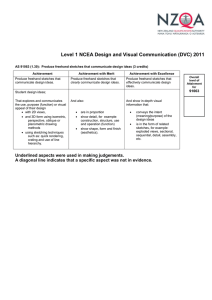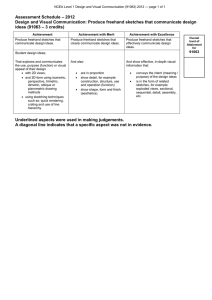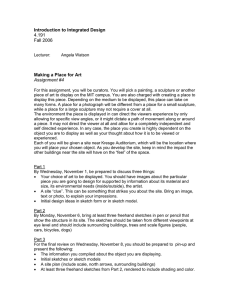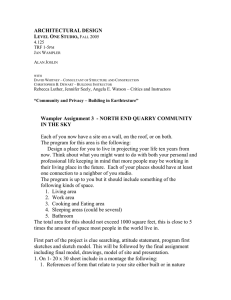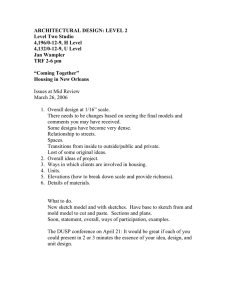Ordinary Level
advertisement
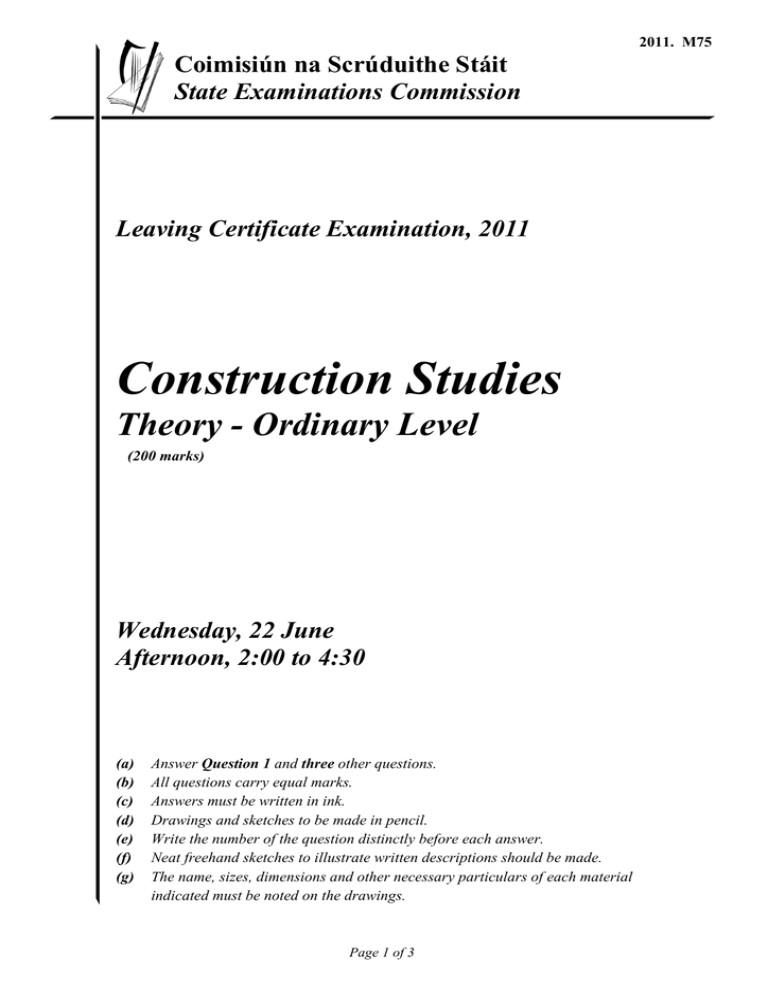
2011. M75 Coimisiún na Scrúduithe Stáit State Examinations Commission Leaving Certificate Examination, 2011 Construction Studies Theory - Ordinary Level (200 marks) Wednesday, 22 June Afternoon, 2:00 to 4:30 (a) (b) (c) (d) (e) (f) (g) Answer Question 1 and three other questions. All questions carry equal marks. Answers must be written in ink. Drawings and sketches to be made in pencil. Write the number of the question distinctly before each answer. Neat freehand sketches to illustrate written descriptions should be made. The name, sizes, dimensions and other necessary particulars of each material indicated must be noted on the drawings. Page 1 of 3 1. 2. A triple glazed timber casement window is fixed in the external wall of a dwelling house, as shown in the sketch. The external wall is a 350 mm concrete block wall with an insulated cavity. The wall is plastered on both sides. The fixed frame of the window is 150 mm × 80 mm. (a) To a scale of 1:5 draw a vertical section through the top portion of the window showing the fixed window frame and the concrete lintels. Show the typical construction details from 300 mm below to a level 400 mm above the concrete lintels. Include four typical dimensions. (b) Show clearly on your drawing the flashing (dpc) and the insulation at the window head. A dwelling house built 40 years ago, as shown in the sketch, has a 300 mm external concrete block wall with a 100 mm un-insulated cavity. The owner intends to refurbish the house to improve the thermal insulation levels of the external walls by: • injecting insulation into the cavity of the external walls and • fixing an internal insulation system to the external walls. 3. 4. (a) For each insulation system listed above, show using notes and neat freehand sketches the procedures to be followed when applying the insulation system. For each system, specify the insulation material used. (b) Discuss one advantage and one disadvantage of each system of insulation. A wood burning stove has a back boiler fitted to heat domestic water for a dwelling house. (a) Using a single-line labelled diagram, show the pipework required to supply hot and cold water to a wash hand basin and to a mixer shower in a bathroom, as shown in the sketch. Include the following in your diagram: • water storage tank and overflow • rising main • indirect cylinder • pipework to wash hand basin and shower • valves and insulation. (b) Discuss two advantages of using a mixer shower as shown, which is connected to the system outlined at 3(a) above, rather than an electric power shower. The sketch shows the layout of a kitchen space. The location of the kitchen cabinets, sink, cooker and fridge is shown. (a) Using notes and neat freehand sketches, show one method of fixing the overhead cabinets to a concrete block wall so that they are both level and secure. (b) A solid wood floor is to be fitted on the existing concrete floor. Using notes and neat freehand sketches show one method of fitting the wooden floor. Recommend a wood suitable for a kitchen floor and give two reasons for your choice. (c) Discuss two advantages of locating the sink, cooker and fridge in the positions shown in the sketch. Page 2 of 3 5. 6. The sketch shows a portion of a closed string timber stairs suitable for a dwelling house. (a) To a scale of 1:5, draw a vertical section through the bottom three steps of the stairs. Show the string, treads and risers and give their typical sizes. (b) Show on your drawing one design detail which will ensure that the stairs does not creak when in use. (a) List two specific safety precautions to be observed in each of the following situations and give one reason for each safety precaution listed: • fitting a precast concrete window cill at ground floor level in a house • working at height when renovating an old house. (b) 7. 8. 9. Using notes and neat freehand sketches, describe two specific safety precautions that should be observed when using a wood turning lathe in school. Give one specific reason why each safety precaution listed should be observed. The sketch shows an outline of a single storey house, an underground rainwater storage tank and a separate rainwater storage tank in the attic of the house. (a) Using notes and neat freehand sketches show the pipework necessary to pump the rainwater from the underground storage tank to the tank in the attic. Label the components and give their typical sizes. (b) Stored rainwater may be used in both a toilet and a washing machine. Show, using notes and neat freehand sketches, the pipework necessary to connect one of these appliances to the storage tank in the attic. Show the necessary valves. (c) Discuss one reason why the rainwater is stored in a separate storage tank in the attic. Explain with the aid of notes and neat freehand sketches, any five of the following: • fascia • strip foundation • thermostatic valve • window board • butt hinge • rafter • solar panel • wall tie • radon barrier. The sketch shows a wooden garden seat designed for use in a public park. (a) Discuss, with the aid of notes and neat freehand sketches, one design feature that makes the seat suitable for outdoor use. (b) Show using notes and neat freehand sketches, a suitable method of jointing the arm rest to the back leg and discuss why the method of jointing shown is suitable. (c) Recommend a suitable applied finish for the garden seat. Describe using notes and freehand sketches, the steps to be followed when preparing the surface of the wood and applying the recommended finish to the garden seat. Page 3 of 3 BLANK PAGE

